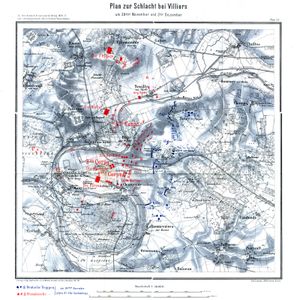Battle of Villiers
| Battle of Villiers | |||||||
|---|---|---|---|---|---|---|---|
| Part of Franco-Prussian War | |||||||
 | |||||||
| |||||||
| Belligerents | |||||||
|
|
| ||||||
| Commanders and leaders | |||||||
|
Albert of Saxony Edouard von Fransecky | Auguste-Alexandre Ducrot | ||||||
| Strength | |||||||
| Württemberg Division | 80,000 | ||||||
| Casualties and losses | |||||||
| 3,529 | 9,477 | ||||||
The Battle of Villiers was the largest of the French sorties from besieged Paris during the Franco-Prussian War.
Background
After the French defeat at the battle of Le Bourget and hearing of the surrender of Metz, morale began to drop in Paris. Attempting to boost moral in the city, General Louis Jules Trochu decided to attempt a breakout which could possibly then link up with the French Army of the Loire.
French Attack
On November 30 Auguste-Alexandre Ducrot led 80,000 men towards the villages of Champigny and Brie on the east bank of the Marne River. This section of the German lines was held by the Württemberg Division of the Prussian 3rd Army. On the 29th the Marne had flooded and a French reconnaissance attack turned into a disaster when 1,300 troops were lost. The main attack was to come the next day followed by a series of diversionary attacks. French artillery drove German advance units from the villages of Brie and Champigny and allowed Ducrot's troops to cross the Marne on pontoon bridges. Ducrot established a bridgehead on the opposite bank of the river at the two villages and advanced up a plateau towards Villiers. The Württemberg Division was so well entrenched that the French artillery did little to dislodge them and the attack stalled. Ducrot called on his III Corps, which had crossed the Marne north of Brie to assault Villiers from the north. The III Corps hesitated too long to attack to be of any use and now Ducrot was fighting a defensive battle.
German Counterattack
The French attack did manage to bring some amount of excitement to the Prussian high command. Chief of Staff Helmuth von Moltke was annoyed with the lack of energy in which Albert of Saxony, commanding the Army of the Meuse, had shown in sending reinforcements to the Wurtemberg Division. Moltke ordered General Edouard von Fransecky to move with his II Corps to the threatened area and assume command of all operations there. Fransecky however had not been notified in time to do anything about the fight on the 30th. December 1 the two armies called a truce and buried their dead. On December 2 a similar situation faced the Germans as had at the battle of Le Bourget. Fransecky did not feel that a counterattack was necessary since the main German line had not been broken yet, just as he had at Le Bourget, Albert pushed for a counter attack anyway. Fransecky's attack was so rapid that it quickly took Champigny. The French were then rallied and a stalemate ensued for the rest of the day. The situation worried Moltke enough to cause him to draw up plans in case the French would renew their attack the following day and succeed in breaking through. Ducrot however had no intention of renewing the fight. His troops had suffered greatly in the cold and even though he received word that the Army of the Loire was moving towards Paris, he withdrew back into Paris by December 4.
Aftermath
The fighting had been costly for both sides. The French over lost 9,000 troop while the Germans lost over 3,000. The Army of the Loire was defeated at the battle of Orleans and Ducrot urged Tochu and Foreign Minister Jules Favre to sue for peace with Prussia.
References
- Howard, Michael Eliot. The Franco-Prussian War: The German Invasion of France, 1870–1871, Second Edition. London: Routledge, 2001. ISBN 0-415-26671-8.
- Villiers, Leaders & Battles Database
